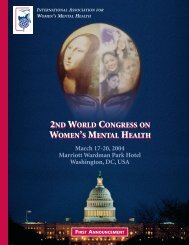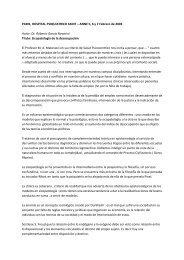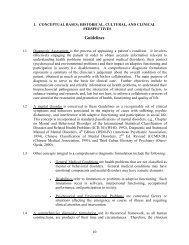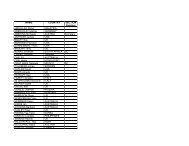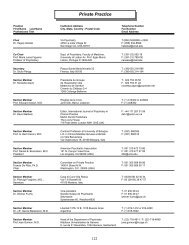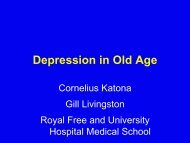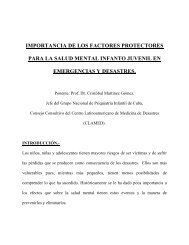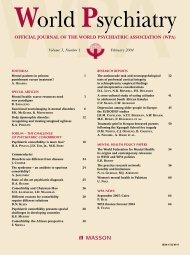ABSTRACTS - World Psychiatric Association
ABSTRACTS - World Psychiatric Association
ABSTRACTS - World Psychiatric Association
Create successful ePaper yourself
Turn your PDF publications into a flip-book with our unique Google optimized e-Paper software.
sis would not just be OCD with poor insight (the only subtype of<br />
OCD currently recognized in the DSM-IV), but would also include<br />
OCD with high motor symptoms (for OCD patients with tics) or<br />
OCD with a high impulsive component (which might include compulsive<br />
shopping, compulsive gambling or trichotillomania). Utilizing<br />
the dimensional approach will help to ensure that, from the onset, an<br />
OCD with high unstable mood (i.e., OCD with comorbid bipolar disorder)<br />
would be diagnosed and treated appropriately (with antiobsessive<br />
and mood stabilizers). Combining the threshold system<br />
with dimensional components would extend the diagnostic procedure<br />
from a one-step categorical approach (either having OCD or<br />
not) to a two-step procedure, the second step being the “profile” of<br />
the particular patient, based on the dimensions. The idea is to look<br />
for alternative tools to use dimensions as a potential scheme for<br />
improving diagnosis and treatment in OCD.<br />
US3.<br />
TREATMENT ADVANCES IN CHILD PSYCHIATRY<br />
US3.1.<br />
TREATMENTS IN CHILD AND ADOLESCENT<br />
PSYCHIATRY: UPDATE 2009<br />
J.L. Rapoport<br />
Child Psychiatry Branch, National Institute of Mental Health,<br />
Bethesda, MD, USA<br />
Landmark studies over the past few decades have established the<br />
importance of an evidence based approach in child and adolescent<br />
psychiatry. For example, the Isle of Wight epidemiological studies, utilizing<br />
standardized ratings, randomized assignment, and contrast<br />
groups, placebo controlled trials and long-term prospective follow-up<br />
studies advanced the field remarkably. In this highly selective review,<br />
three examples of important treatment findings are highlighted<br />
because of both their practical implications and heuristic importance.<br />
First, placebo controlled trials of mood stabilizers in “bipolar spectrum”<br />
are reviewed. These studies support great caution in the use of<br />
mood stabilizers in bipolar “spectrum” children. Secondly, a successful<br />
school based training trial of executive function in preschool children<br />
is discussed as an inexpensive and possibly preventive approach.<br />
Finally, important advances in a treatment trial leading to substantial<br />
prevention of cerebral palsy are covered. Since half of cerebral palsy<br />
children have psychiatric disorders, this study has major implications<br />
for preventive pharmacological intervention in child psychiatry.<br />
US3.2.<br />
TREATMENTS OF AUTISM SPECTRUM DISORDERS:<br />
AN UPDATE<br />
B.L. Leventhal<br />
Institute for Juvenile Research, University of Illinois, Chicago,<br />
IL, USA<br />
Extensive studies in recent years have dramatically changed the outlook<br />
and perspectives on autistic disorder. First of all, international<br />
collaborative studies have developed standard diagnostic tools and<br />
the only agreement between DSM and ICD for the diagnostic criteria<br />
for a disorder. The agreement on phenotype has lead to an understanding<br />
that autistic disorder is one of a group of conditions now<br />
considered under the rubric of autism spectrum disorders (ASD) and<br />
to extensive epidemiologic studies that now allow for the appreciation<br />
of ASD as relatively common conditions, affecting some 0.6-0.7% of<br />
the population. This perspective has added new gravity to the importance<br />
of understanding the etiology and development of evidencebased<br />
treatments for ASD. While the etiology of autism still remains<br />
unclear (and there are many competing, often non-evidence based<br />
theories), it is becoming increasingly clear that ASD have a strong biological<br />
substrate, with genetics playing a key role in the pathophysiologic<br />
processes that lead to very early (possibly prenatal) disruptions<br />
in brain development. As the genetics and pathophysiology are being<br />
sorted out, studies now suggest that there are safe and effective, evidence-based<br />
treatments that can meaningfully alter the course of the<br />
disorder. While most of these interventions are environmental (language<br />
therapy, education, behavior therapy, social skills training, etc.),<br />
there is also growing evidence of the utility of psychopharmacology as<br />
at least an adjunctive treatment for the symptoms of ASD. The development<br />
of animal models and a developing understanding of the<br />
pathophysiology of ASD is leading to new treatments, some now in<br />
clinical trials, and others that will be available in the very near future.<br />
US3.3.<br />
RECENT ADVANCES IN TREATMENT<br />
OF UNIPOLAR DEPRESSION AND BIPOLAR<br />
DISORDER IN CHILDREN AND ADOLESCENTS<br />
N.D. Ryan<br />
Department of Psychiatry, University of Pittsburgh School<br />
of Medicine, Western <strong>Psychiatric</strong> Institute and Clinic, Pittsburgh,<br />
PA, USA<br />
The research and clinical experience from past five years has provided<br />
many new insights to the pharmacological and psychological treatment<br />
of child psychiatric disorders. Recent clinical studies and important<br />
clinical data have further clarified and changed our approaches to<br />
both unipolar disorder and bipolar disorder in children and adolescents.<br />
In the treatment of unipolar depression, large scale studies,<br />
including the Treatment for Adolescents with Depression Study<br />
(TADS) and the Treatment of Resistant Depression in Adolescents<br />
(TORDIA), have taught us more about how to use both medications<br />
and psychotherapy in the initial treatment of these disorders and in the<br />
treatment of refractory depression. Over the same time, multiple studies<br />
have shed at least partial light on the vexing question of whether or<br />
not antidepressants overall increase or decrease the ultimate risk for<br />
suicide. In the treatment of bipolar disorder, much more data is now<br />
available on the safe and efficacious use of atypical antipsychotics as<br />
well as other mood stabilizers and we are starting to see studies of psychotherapeutic<br />
approaches useful in combination with medications<br />
for bipolar disorder. At the same time, some studies have suggested a<br />
place for first-generation antipsychotics in the treatment of children.<br />
US4.<br />
OUTCOME IN BIPOLAR DISORDERS: NEW<br />
FINDINGS AND METHODOLOGICAL CHALLENGES<br />
US4.1.<br />
AN ARRAY OF OUTCOMES: RECENT FINDINGS<br />
ON PREDICTION<br />
W. Coryell<br />
University of Iowa Carver College of Medicine, Iowa City, IA, USA<br />
Recent years have seen a rapid increase in new knowledge of the<br />
short- and long-term course of bipolar affective disorders. Outcome<br />
measures have moved beyond simple times to recovery and relapse<br />
and the quantification of excess mortality to include such outcomes as<br />
switching, chronic psychosis and diagnostic revisions, the examina-<br />
9



